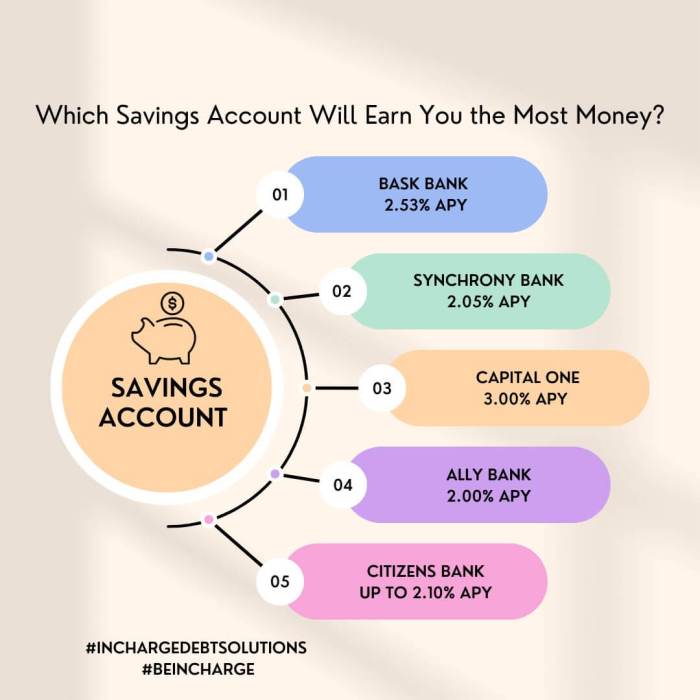When it comes to managing your finances, choosing the right savings account can make all the difference. From traditional options to high-yield accounts, the world of savings offers a variety of choices to help you reach your financial goals. Let’s dive into the realm of savings account options and uncover the best strategies for maximizing your savings potential.
In this guide, we’ll break down the different types of savings accounts, explore how interest rates and fees play a role in your savings growth, delve into minimum balance requirements, and compare the benefits of online versus brick-and-mortar banks. Get ready to take charge of your financial future!
Types of Savings Accounts

When it comes to saving that hard-earned cash, you’ve got options, baby. Let’s break it down for you.
Regular Savings Accounts vs. High-Yield Savings Accounts
Regular savings accounts are like the OGs of the banking world. They’re safe, easy to access, and usually have low minimum balance requirements. But when it comes to making that money work for you, high-yield savings accounts are where it’s at. These bad boys offer higher interest rates, helping you grow your savings faster.
Money Market Accounts vs. Traditional Savings Accounts
Now, if you want to take things up a notch, consider a money market account. These accounts often come with higher interest rates than traditional savings accounts and may even offer check-writing privileges. Plus, they usually have a higher minimum balance requirement, so you know you’re dealing with the big leagues.
Interest Rates and Fees
When it comes to savings accounts, interest rates and fees play a crucial role in determining how much your money can grow over time. Understanding how these factors work can help you make informed decisions about where to keep your savings.
Interest Rates:
Interest rates can vary significantly among different savings accounts. Generally, online banks tend to offer higher interest rates compared to traditional brick-and-mortar banks. The Annual Percentage Yield (APY) is a key factor to consider when comparing savings accounts, as it represents the total amount of interest you will earn on your savings in one year. It’s important to choose an account with a competitive APY to maximize your earnings.
Fees Impact:
Fees can eat into your savings and impact the overall growth of your money. Common fees associated with savings accounts include monthly maintenance fees, ATM withdrawal fees, overdraft fees, and minimum balance fees. To avoid unnecessary charges, make sure to read the fine print of any account you’re considering and opt for accounts with minimal fees.
Examples of Common Fees:
1. Monthly Maintenance Fee: This fee is charged by some banks for the upkeep of your account.
2. ATM Withdrawal Fee: Some banks charge a fee when you use an ATM that is outside their network.
3. Overdraft Fee: If you spend more money than what is available in your account, you may incur an overdraft fee.
4. Minimum Balance Fee: This fee is charged if your account balance falls below a certain threshold.
Remember, choosing a savings account with competitive interest rates and minimal fees can help you grow your savings more effectively over time.
Minimum Balance Requirements
To keep your savings account in good standing, it’s crucial to understand the minimum balance requirements set by the bank. Let’s dive into how these requirements vary and what you can do to avoid any penalties.
Differing Minimum Balances
Different savings accounts may have varying minimum balance requirements, ranging from as low as $5 to a few thousand dollars. Some accounts might even waive the minimum balance if certain conditions are met, such as setting up direct deposit.
Consequences of Falling Below
If you dip below the minimum balance required for your savings account, you may face penalties or fees. These charges can eat into your savings and undo the hard work you’ve put into building them up. It’s essential to stay above the threshold to avoid these consequences.
Maintaining the Minimum Balance
To ensure you meet the minimum balance requirements, consider setting up alerts to notify you if your balance is getting close to the threshold. You can also automate transfers from your checking to savings account to keep the balance up. Budgeting and tracking your expenses can also help you maintain the required minimum balance without any hassle.
Online vs. Brick-and-Mortar Banks
Opening a savings account with an online bank offers several benefits compared to a traditional brick-and-mortar bank. Online banks typically have higher interest rates, lower fees, and often no minimum balance requirements. Additionally, online banks provide 24/7 access to your account through websites and mobile apps, making it convenient to manage your finances from anywhere.
Convenience of Managing a Savings Account Online
- Access your account anytime, anywhere
- Transfer funds between accounts easily
- Set up automatic transfers and payments
- Monitor your account activity in real time
Security Measures for Online Savings Accounts
Online banks use encryption technology to protect your personal and financial information. They also offer multi-factor authentication and monitoring tools to detect and prevent fraudulent activities.
